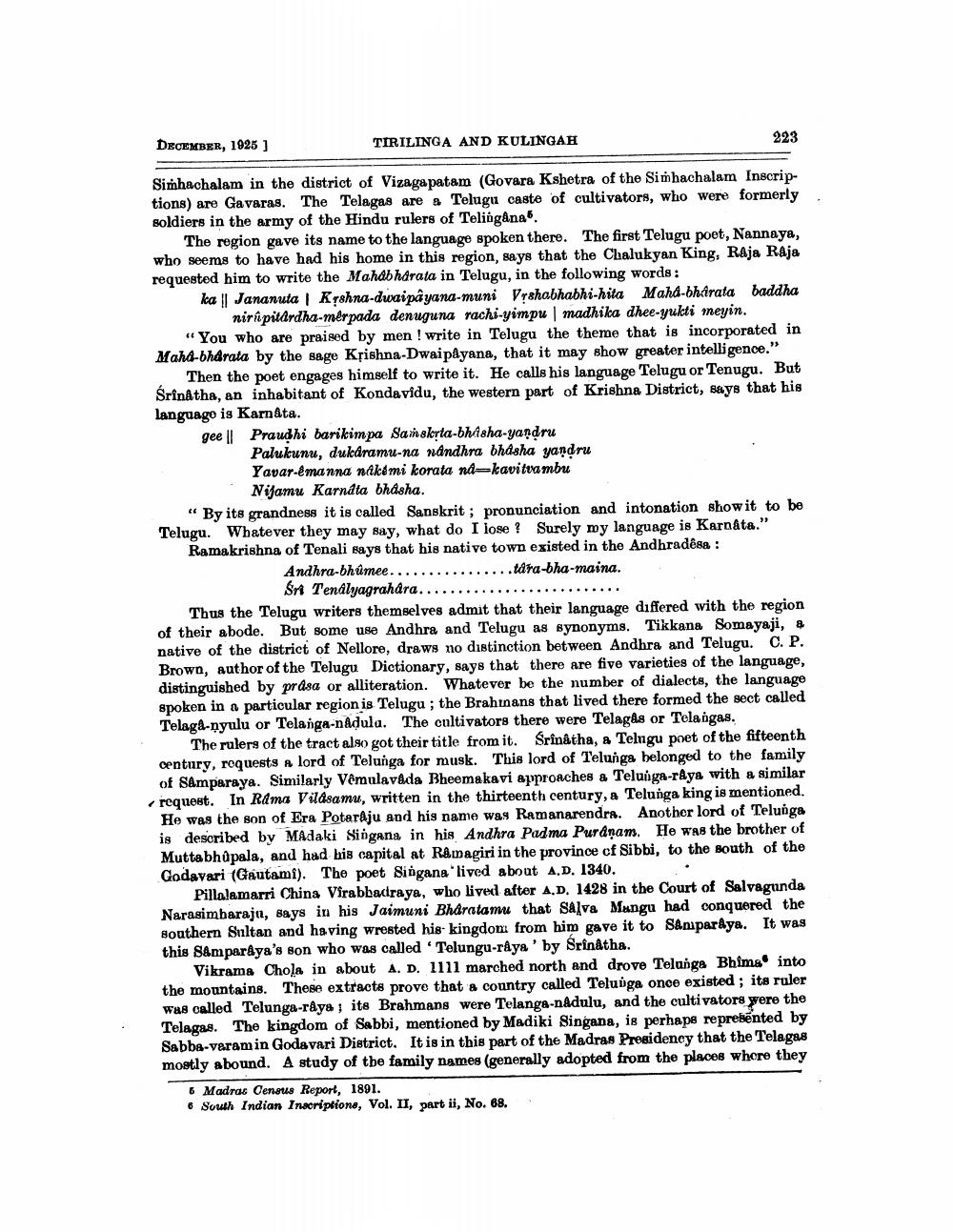________________
TIRILINGA AND KULINGAH
223
DECEMBER, 1925 ]
Simhachalam in the district of Vizagapatam (Govara Kshetra of the Simhachalam Inscriptions) are Gavaras. The Telagas are a Telugu caste of cultivators, who were formerly soldiers in the army of the Hindu rulers of Telingana".
The region gave its name to the language spoken there. The first Telugu poet, Nannaya, who seems to have had his home in this region, says that the Chalukyan King, Raja Raja requested him to write the Mahabharata in Telugu, in the following words:
ka | Jananuta | Krshna-dwaipayana-muni Vrshabhabhi-hita Mahd-bharata baddha nirûpitârdha-mérpada denuguna rachi-yimpu | madhika dhee-yukti meyin. "You who are praised by men! write in Telugu the theme that is incorporated in Maha-bharata by the sage Krishna-Dwaipayana, that it may show greater intelligence."
Then the poet engages himself to write it. He calls his language Telugu or Tenugu. But Śrinatha, an inhabitant of Kondavidu, the western part of Krishna District, says that his language is Karnâta.
gee
Praudhi barikimpa Samskrta-bhisha-yandru
Palukunu, dukâramu-na nandhra bhasha yanḍru Yavar-êmanna nakémi korata na kavitvambu Nijamu Karnata bhasha.
"By its grandness it is called Sanskrit; pronunciation and intonation show it to be Telugu. Whatever they may say, what do I lose? Surely my language is Karnata." Ramakrishna of Tenali says that his native town existed in the Andhradêsa:
Andhra-bhûmee....
.tara-bha-maina.
Sri Tenályagrahara...
Thus the Telugu writers themselves admit that their language differed with the region of their abode. But some use Andhra and Telugu as synonyms. Tikkana Somayaji, a native of the district of Nellore, draws no distinction between Andhra and Telugu. C. P. Brown, author of the Telugu Dictionary, says that there are five varieties of the language, distinguished by prása or alliteration. Whatever be the number of dialects, the language spoken in a particular region is Telugu; the Brahmans that lived there formed the sect called Telaga-nyulu or Telanga-nadula. The cultivators there were Telagas or Telangas.
The rulers of the tract also got their title from it. Srinatha, a Telugu poet of the fifteenth century, requests a lord of Telunga for musk. This lord of Telunga belonged to the family of Samparaya. Similarly Vêmulavada Bheemakavi approaches a Teluiga-raya with a similar request. In Rama Vildsamu, written in the thirteenth century, a Telunga king is mentioned. He was the son of Era Potarâju and his name was Ramanarendra. Another lord of Telunga is described by MAdaki Singana in his Andhra Padma Puranam. He was the brother of Muttabhupala, and had his capital at Râmagiri in the province of Sibbi, to the south of the Godavari (Gautami). The poet Singana lived about A.D. 1340.
Pillalamarri China Virabhadraya, who lived after A.D. 1428 in the Court of Salvagunda Narasimharaju, says in his Jaimuni Bharatamu that Salva Mungu had conquered the southern Sultan and having wrested his kingdom from him gave it to Sanparaya. It was this Samparaya's son who was called Telungu-raya' by Srinatha.
Vikrama Chola in about A. D. 1111 marched north and drove Telunga Bhima into the mountains. These extracts prove that a country called Teluiga once existed; its ruler was called Telunga-raya; its Brahmans were Telanga-nadulu, and the cultivators were the Telagas. The kingdom of Sabbi, mentioned by Madiki Singana, is perhaps represented by Sabba-varam in Godavari District. It is in this part of the Madras Presidency that the Telagas mostly abound. A study of the family names (generally adopted from the places where they
6 Madras Census Report, 1891.
6 South Indian Inscriptions, Vol. II, part ii, No. 68.




